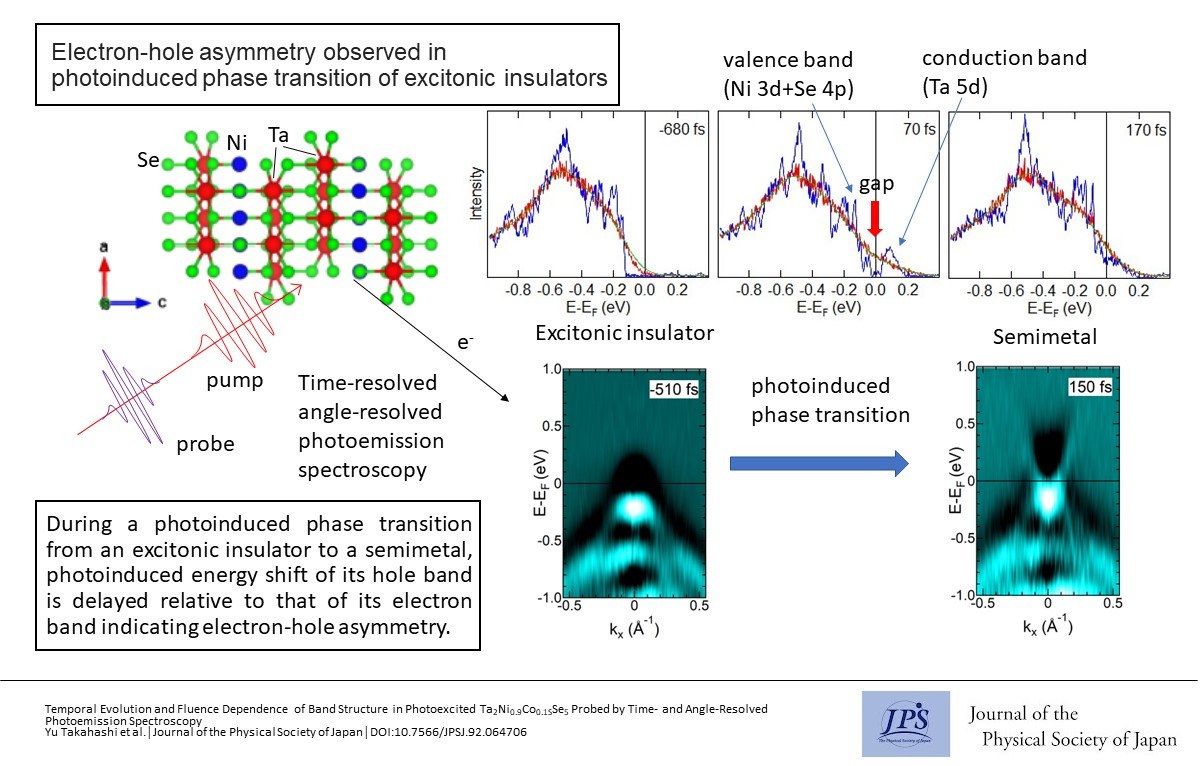Electron-Hole Asymmetry Observed in Photoinduced Phase Transition of Excitonic Insulators
© The Physical Society of Japan
This article is on
Temporal Evolution and Fluence Dependence of Band Structure in Photoexcited Ta2Ni0.9Co0.1Se5 Probed by Time- and Angle-Resolved Photoemission Spectroscopy
(JPSJ Editors' Choice)
J. Phys. Soc. Jpn. 92, 064706 (2023).
During a photoinduced phase transition from an excitonic insulator to a semimetal, photoinduced energy shift of its hole band is delayed than that of its electron band indicating electron-hole asymmetry.

Existence of excitonic insulators was theoretically predicted in 1960s. They can be realized if conduction and valence bands in a semiconductor or semimetal are hybridized by the electron-hole attractive Coulomb interaction. The electron-hole hybridization by the attractive Coulomb interaction can be viewed as a Bose-Einstein condensation of bounded electron-hole pairs or excitons. In 2009, a layered transition-metal chalcogenide Ta2NiSe5 was proposed to be an excitonic insulator. This has been confirmed by various experimental techniques. In particular, a photoinduced phase transition with 100 fs time scale from the excitonic insulating state to a semimetal state is one strongest proof. In the present study, the photoinduced energy shift of conduction and valence bands (electron and hole bands) of Ta2Ni0.9Co0.1Se5 (which is also an excitonic insulator) is investigated by time-resolved angle-resolved photoemission spectroscopy. In a canonical excitonic insulator, valence and conduction bands are expected to shift simultaneously to close the energy gap between them owing to the screening effect of the photoinduced carriers. However, in Ta2Ni0.9Co0.1Se5, the energy shift of the valence band is delayed than that of the conduction band. This observation indicates that the electron-hole symmetry (which is assumed in the canonical theory for excitonic insulators) is broken and that the mechanism of the electron-hole hybridization is complicated in the layered transition-metal chalcogenide. We speculate that the electron-lattice interaction and electronic correlation in the valence band of Ni 3d and Se 4p orbitals provide the residual and transient energy gap during the photoinduced phase transition to the semimetal state.
(written by T. Mizokawa on behalf of all authors.)
Temporal Evolution and Fluence Dependence of Band Structure in Photoexcited Ta2Ni0.9Co0.1Se5 Probed by Time- and Angle-Resolved Photoemission Spectroscopy
(JPSJ Editors' Choice)
J. Phys. Soc. Jpn. 92, 064706 (2023).
Share this topic
Fields
Related Articles
-
Discovery of Light-Induced Mirror Symmetry Breaking
Dielectric, optical, and other properties in condensed matter
Electronic transport in condensed matter
2024-9-2
The authors discovered the light-induced mirror symmetry breaking, paving the way for controlling mirror symmetries via light and for realizing various phenomena utilizing the mirror symmetry breaking.
-
Antiferromagnetism Induces Dissipationless Transverse Conductivity
Electronic transport in condensed matter
Magnetic properties in condensed matter
Electronic structure and electrical properties of surfaces and nanostructures
2024-7-24
An investigation using high-quality NbMnP crystals demonstrates that the anomalous Hall conductivity arising from antiferromagnetism is dissipationless, as expected from the intrinsic mechanism.
-
d2 Trimer and d3 Tetramer in a Pyrochlore Lattice
Dielectric, optical, and other properties in condensed matter
Electron states in condensed matter
2024-7-11
Based on the charge disproportionation of V3+ and V2+, the V3+(d2) trimers and V2+(d3) tetramers in the vanadium pyrochlore lattice of AlV2O4 are described by the orbitally-induced Peierls mechanism.
-
Structural Rotation and Falsely Chiral Antiferromagnetism: A New Combination Generating Ferrotoroidic State
Magnetic properties in condensed matter
Dielectric, optical, and other properties in condensed matter
2024-7-4
The ferrotoroidic state, an exotic state of matter with broken space inversion and time-reversal symmetries, was achieved by combining structural rotation and falsely chiral antiferromagnetism in PbMn2Ni6Te3O18.
-
Current Melt Frozen Electrons
Dielectric, optical, and other properties in condensed matter
Magnetic properties in condensed matter
2024-1-15
The origin of the current-induced insulator-to-metal transition of samarium monosulfide was explained by the 4f−5d hybridization observed using optical reflectivity and photoelectron spectroscopies.
